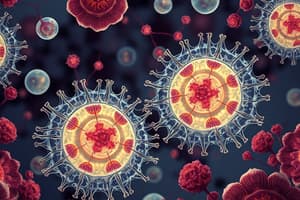Podcast
Questions and Answers
What is the primary function of vacuoles in plant cells?
What is the primary function of vacuoles in plant cells?
- Store materials and maintain turgor pressure (correct)
- Synthesize proteins
- Regulate cellular respiration
- Detoxify harmful substances
Which statement best describes the role of lysosomes?
Which statement best describes the role of lysosomes?
- Aid in protein synthesis
- Provide structural support to the cell
- Digest macromolecules and recycle digested products (correct)
- Store energy and nutrients in the cell
What is the function of peroxisomes in the cell?
What is the function of peroxisomes in the cell?
- Store proteins for cellular use
- Detoxify harmful substances using oxidative enzymes (correct)
- Synthesize lipids and carbohydrates
- Facilitate cell division
How does the vacuole in animal cells differ from that in plant cells?
How does the vacuole in animal cells differ from that in plant cells?
What structure is known as the 'cell coat' and its main role?
What structure is known as the 'cell coat' and its main role?
What is the primary function of the cell membrane?
What is the primary function of the cell membrane?
Which of the following correctly describes a function of organelles?
Which of the following correctly describes a function of organelles?
Which of the following statements about the cell wall is true?
Which of the following statements about the cell wall is true?
What are ribosomes primarily responsible for?
What are ribosomes primarily responsible for?
What characteristic distinguishes the smooth endoplasmic reticulum from the rough endoplasmic reticulum?
What characteristic distinguishes the smooth endoplasmic reticulum from the rough endoplasmic reticulum?
Which statement is true regarding the cytosol?
Which statement is true regarding the cytosol?
Which type of membrane best describes the nature of the cell membrane?
Which type of membrane best describes the nature of the cell membrane?
What is a common structural characteristic of organelles?
What is a common structural characteristic of organelles?
What is the primary function of the rough endoplasmic reticulum?
What is the primary function of the rough endoplasmic reticulum?
What is the major structural feature of the Golgi apparatus?
What is the major structural feature of the Golgi apparatus?
Which organelle is known as the 'powerhouse of the cell'?
Which organelle is known as the 'powerhouse of the cell'?
Which part of the cell is responsible for detoxifying drugs?
Which part of the cell is responsible for detoxifying drugs?
What describes the endoplasmic reticulum’s structure?
What describes the endoplasmic reticulum’s structure?
Which organelle is involved in the modification and packaging of proteins for secretion?
Which organelle is involved in the modification and packaging of proteins for secretion?
How are proteins transported from the rough endoplasmic reticulum to other parts of the cell?
How are proteins transported from the rough endoplasmic reticulum to other parts of the cell?
What type of material do ribosomes primarily synthesize?
What type of material do ribosomes primarily synthesize?
Study Notes
VACUOLES
- Serve as storage for materials and water, and manage cellular waste.
- In plants, vacuoles are large, playing a crucial role in turgor pressure and water storage.
- In animals, vacuoles are smaller, primarily storing food products.
PEROXISOMES
- Membranous sacs containing oxidative enzymes for detoxifying harmful substances.
LYSOSOMES
- Often referred to as the "scavenger of the cell" or "suicidal bag of the cell."
- Contain strong hydrolytic enzymes for digesting macromolecules.
- Digestive products are reused by the cell for synthesizing cellular materials.
CELL MEMBRANE
- A semi-permeable membrane that acts as a gate for the cell.
- Composed of a phospholipid bilayer, fats, carbohydrates, and proteins.
- Provides support and shape to the cell, while acting as receptor sites.
- Permeable: allows substances to enter; Non-permeable: blocks substances; Semi-permeable: selectively allows certain substances in and out.
CYTOPLASMIC ORGANELLES
- Also known as tiny organs, which perform individual tasks within the cell.
- Each organelle is membrane-enclosed, typically within its own lipid bilayer.
CELL WALL
- The external boundary of plant cells, composed of cellulose.
- Protects plants from pathogens and prevents dryness.
RIBOSOMES
- Small rounded structures made of ribosomal proteins and ribonucleic acids.
- Responsible for connecting amino acids to form long protein chains.
- Act as builders of protein materials and are essential for protein synthesis.
SMOOTH ENDOPLASMIC RETICULUM (SER)
- Composed of tubular sacs lacking ribosomes on its surface.
- Functions in detoxifying drugs and manufacturing lipids and carbohydrates.
GOLGI APPARATUS (GOLGI BODIES/DICTYOSOME)
- Made up of stacks of flattened membranous sacs.
- Transports proteins from the rough endoplasmic reticulum to other cellular locations.
- Functions as the post office or packaging center of the cell by processing and secreting proteins.
ENDOPLASMIC RETICULUM (ER)
- A network of interconnected tubes and flattened sacs extending throughout the cytoplasm.
- Functions as the highway of the cell, facilitating transport and communication between organelles.
MITOCHONDRIA
- Known as the powerhouse of the cell.
- Site for the synthesis of Adenosine Triphosphate (ATP), the cell's energy currency.
ROUGH ENDOPLASMIC RETICULUM (RER)
- Composed of flattened membranous tubes with ribosomes on its surface.
- Involved in the manufacturing, folding, and synthesis of protein materials.
Studying That Suits You
Use AI to generate personalized quizzes and flashcards to suit your learning preferences.
Related Documents
Description
Explore the essential functions of vacuoles in plant and animal cells. This quiz covers topics such as material storage, hydrostatic pressure maintenance, and the role of the cell coat in cellular recognition and adhesion.




